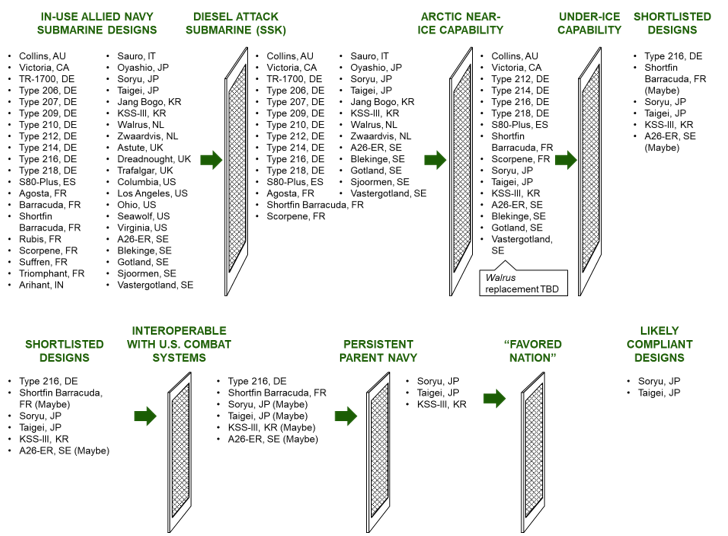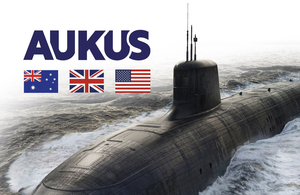GR66
Army.ca Veteran
- Reaction score
- 4,840
- Points
- 1,160
This article discusses arctic capable submarines in a Chinese context but they are equally applicable to Canada.Recent news regarding the defence cuts notwithstanding, I will continue to move forward with the thought that the Canadian Patrol Submarine Project will continue because of the potential boost to the Canadian Defence Industry and jobs. Not with the actual building of the submarine, but the components that would into the vessel, and the future upgrades and modernization that would occur after it has been in service.
Excellent article with regards to the Canadian Patrol Submarine Project. I'm not an expert about submarine operations and technology but the final choices that came through the filters did surprise me.
Existing Submarine Designs That Could Meet Canada’s Needs
As the Canadian Patrol Submarine Project considers how to best replace the Victoria-class and deliver the military capabilities that Canada could need in this period of great-power conflict, it might find it useful to understand how well existing platforms deliver those capabilities. Canada’s path to replacing the Victoria class could be easier – both in cost and schedule – if existing designs are able to deliver Canada’s preferred capabilities.
While Canada has not formally announced its requirements for the Canadian Patrol Submarine Project, public comments indicate that Canada’s requirements may include:
Using publicly available information, we assessed 41 allied navy submarine designs against these potential requirements (Figure 1), identifying 3 submarine designs that could meet Canada’s potential requirements: Japan’s Soryu and Taigei classes, and South Korea’s KSS-III class.
- Diesel attack submarine (SSK)
- Operating range of 6,000 nm
- Under-ice capability
- Interoperable with the U.S.’s Virginia-class combat system (leveraging Canada’s prior investment in this system)
- An established, persistent parent navy (to reduce Canada’s in-service support burden)
If valid, this assessment has potential implications for Canada’s approach:
- Canada’s potential requirements may not be commonly found together, implying that Canada might need to be flexible on requirements (e.g., under-ice capability, persistent parent navy), willing to engage in a limited-competition procurement (e.g., 1 or 2 bidders), or able to shoulder the design-build cost of a new, bespoke design
- The combination of SSK and under-ice capable is relatively rare – many nuclear submarines can operate under-ice, but not many diesel attack submarines can
- Several potentially attractive designs have not been built (e.g., Shortfin Barracuda, Type 216, A26-ER), and Canada would likely incur additional costs due to first-of-class cost growth and the in-service support burdens that fall to a parent navy
- If only 3 operating submarine designs meet Canada’s potential requirements, there may not be an opportunity to buy a “used” submarine (like Canada did with the Upholder / Victoria), potentially forcing Canada into a more expensive acquisition of new submarines

Figure 1. Comparison of 41 allied submarine designs with Canada’s potential requirements.
Conclusion
It is possible that the requirements that best meet Canada’s needs are a rare combination: few navies need to cover Canada’s extent of Arctic territory, and those that do (e.g., Russia, U.S.) choose to do so with nuclear, not diesel, submarines. Understanding the implication of requirements on available designs could help the Canadian Patrol Submarine Project optimize Canada’s capability needs, schedule requirements, and available budget. Conversely, setting requirements before understanding which existing designs are feasible could put Canada on the same path that Australia recently abandoned: a prohibitively expensive, bespoke, diesel submarine.
The article goes on to discuss many of the design requirements in building a submarine capable of breaking through the ice (and the risks involved).Despite the seeming potential for an Arctic (or “Near-Arctic”) capability, AIP systems will likely continue to be insufficient for the harsh requirements of the Arctic environment. They are fairly low-power and do not appear capable of propelling submarines at high speeds for long durations, making their increased endurance more suitable for extended loitering missions within a relatively small area, rather than oceanic transits and distantwater patrols, as would be the case for any Chinese boat attempting to reach the Arctic. Even if an AIP submarine reaches the Arctic Ocean, air access would remain essential for when the AIP fuels are exhausted. Air-fed diesel operations will continue to constrain where and how such submarines could operate under ice. Indeed, the constant search for polynyas or transient leads would dominate AIP sub planning and areas of operation.Furthermore, non-nuclear submarines tend to be smaller than their nuclear counterparts, which reduces the mass with which they can push through the ice cover when surfacing.12As a result, despite the narrowing gap in underwater endurance between AIP and nuclear propulsion, the latter remains necessary for any Chinese Arctic-capable submarine. In the context of the PLAN submarine force, this means that of the current fleet of 66 submarines, the 55 that are diesel-electric-powered are unsuitable for Arctic operations. Although nuclear submarine numbers are expected to grow to thirteen SSNs and eight SSBNs by 2030, any level of continuous Arctic presence would cut into this small force by at least 15% assuming the highly unlikely probability of 100% availability. As we have previously argued, given the limited land attack and sea denial opportunities available in the North American Arctic, this would be a poor use of resources.
Then there are the difficulties of operating in an under-ice environment while also remaining undetected
If Canada gets SSKs (AIP or not) I don't really see us planning on any extensive under-ice operation. Much more likely we will patrol the choke points leading out from under the ice and use alternative sensors to detect foreign subs trying to operate in the narrow confines of the NWP. So I think that makes the original article's filters for "Arctic near-ice Capability" and "Under Ice Capability" somewhat meaningless.Because of the difficulty and potential damage from surfacing through ice, submarines try to avoid it when possible. As such, one of a boat’s chief navigational concerns is keeping track of polynyas, thin ice, and open leads. This consideration means equipping submarines with upward-looking sonar or light sensors, which allow a boat to detect thin ice, at least when sailing directly beneath it. The ever-shifting nature of leads, and to a lesser extent polynyas, means that any submarine seeking assured access to the air above will need to continually map the underside of the sea ice with these sonars, potentially revealing their location to enemies, despite the relatively short range of these sonars. In areas of thinner ice, light-based sensors can accomplish the task with greater stealth and, as such, the equipping of vessels with that technology is a potential indicator that a submarine is being prepared for Arctic operations. The risk of discovery through the use of active navigational sonar also applies to the journey to the Arctic. Chinese submarines would need to traverse the narrow and shallow Bering Strait to reach polar waters and those geographical constraints are an important consideration. As a submarine attempts to make its way through the confined waters of the Bering Strait, it encounters not only the relatively shallow bottom, but –especially in winter – compressed sea ice above that reaches down for dozens of metres below the surface in the form of ice ridges and pinnacles. This unpredictable “ice jungle” defines the Bering region (as well as other marginal ice zones) and requires specialized systems. A safe path has to be identified using the boat’s obstacle avoidance sonar, systems that are also used to look for underwater mines. As with the upward-looking sonar search for polynyas, the use of such forward-looking sonars, combined with the Bering Strait’s narrowness, makes submarines vulnerable to detection. Any Arctic submarine would therefore have to be equipped with both upward- and forward-looking navigational sonars, generally mounted on the sail, in order to operate successfully in the region. While specialized equipment is essential, optimizing an Arctic submarine is also a matter of size. In peacetime, transits through the worst of the ice jungle can be made without much trouble. In a wartime environment, however, it becomes more difficult because of the need to minimize active ice-avoidance sonar and transit at greater speeds. A quick transit is also safer and easier for smaller craft, a conclusion that the US Navy’s Arctic Submarine Laboratory (ASL) came to decades ago. Waldo K. Lyon, ASL chief and father of the US Arctic submarine program, argued that contrary to Cold War trends, smaller and shorter submarines would have a dramatic combat advantage in the marginal ice zone. Their ability to sail between and under the ice both allows them to hide from other submarines and position themselves for an attack. Cold War torpedo trials showed the difficulties of tracking and identifying targets in the ice jungle, owing to interference with sonar signals. Meanwhile, a submarine already within the ice could more reliably achieve an accurate torpedo track on a submarine that was outside the ice. A submarine built to maximize its ability to fight in ice-covered waters would be relatively small, closer to second generation American SSNs like the 292-foot Sturgeon class than the current 362 foot Los Angeles, 353-foot Seawolfs, or the 377-foot Virginias (increased to 460 feet for the future Block V variant). A smaller diameter hull would also be favourable, as it reduces the clearance needed to sail safely between ice keels and the seafloor, increasing maneuverability as the boat banks during turns. Such maneuverability would also be assisted by retractable auxiliary motors, enabling the submarine to move with much greater agility at low speeds between ice keels. Such motors were employed by the Sturgeons to position themselves under polynyas in preparation for surfacing and have since been installed on all American SSNs to assist with docking and special warfare missions.
I'm also guessing their classification of their selected subs meeting these filters contains much more fantasy than reality based on the design requirements for under ice operations that are noted in the link I provided. I doubt either the Japanese or Korean subs have included the type of design features that are required for extensive under-ice operations.





